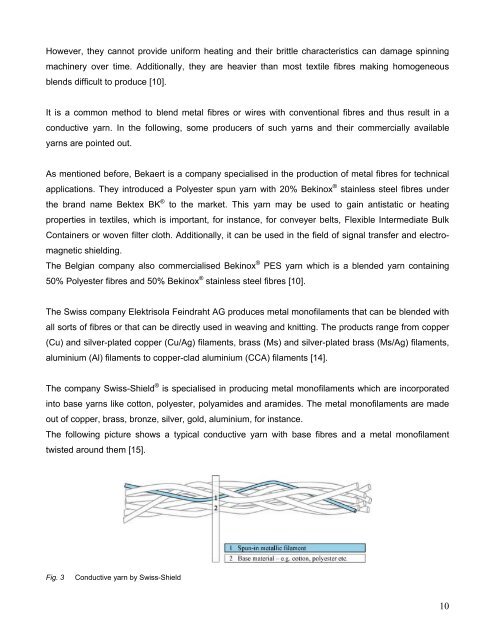Clevertex - Grado Zero Espace Srl
Clevertex - Grado Zero Espace Srl
Clevertex - Grado Zero Espace Srl
You also want an ePaper? Increase the reach of your titles
YUMPU automatically turns print PDFs into web optimized ePapers that Google loves.
However, they cannot provide uniform heating and their brittle characteristics can damage spinning<br />
machinery over time. Additionally, they are heavier than most textile fibres making homogeneous<br />
blends difficult to produce [10].<br />
It is a common method to blend metal fibres or wires with conventional fibres and thus result in a<br />
conductive yarn. In the following, some producers of such yarns and their commercially available<br />
yarns are pointed out.<br />
As mentioned before, Bekaert is a company specialised in the production of metal fibres for technical<br />
applications. They introduced a Polyester spun yarn with 20% Bekinox ® stainless steel fibres under<br />
the brand name Bektex BK ® to the market. This yarn may be used to gain antistatic or heating<br />
properties in textiles, which is important, for instance, for conveyer belts, Flexible Intermediate Bulk<br />
Containers or woven filter cloth. Additionally, it can be used in the field of signal transfer and electromagnetic<br />
shielding.<br />
The Belgian company also commercialised Bekinox ® PES yarn which is a blended yarn containing<br />
50% Polyester fibres and 50% Bekinox ® stainless steel fibres [10].<br />
The Swiss company Elektrisola Feindraht AG produces metal monofilaments that can be blended with<br />
all sorts of fibres or that can be directly used in weaving and knitting. The products range from copper<br />
(Cu) and silver-plated copper (Cu/Ag) filaments, brass (Ms) and silver-plated brass (Ms/Ag) filaments,<br />
aluminium (Al) filaments to copper-clad aluminium (CCA) filaments [14].<br />
The company Swiss-Shield ® is specialised in producing metal monofilaments which are incorporated<br />
into base yarns like cotton, polyester, polyamides and aramides. The metal monofilaments are made<br />
out of copper, brass, bronze, silver, gold, aluminium, for instance.<br />
The following picture shows a typical conductive yarn with base fibres and a metal monofilament<br />
twisted around them [15].<br />
Fig. 3 Conductive yarn by Swiss-Shield<br />
10

















